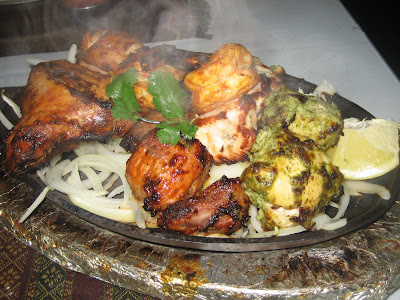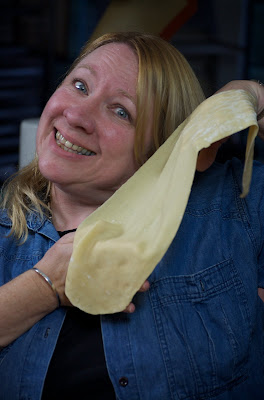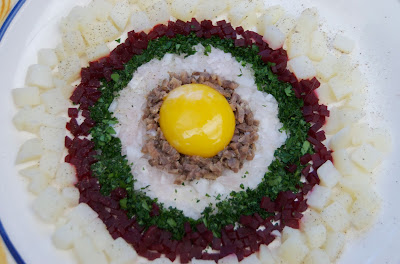“I’m sorry, we’ve run out of karma,” is not exactly what you expect to hear someone say in a restaurant.
But Himself and I were at Tibet Nepal House in Old Town Pasadena, and the server was telling the people at the next table that one of the restaurant’s Himalayan beers was out of stock.
No worries for us, because we were sipping Old Monk Super Beer and enjoying its smoky flavor. While our server called it a “heavy beer,” it’s what we in the States call malt liquor. Later I looked it up online to see what I could learn. The reviews were quite savage (one said it “smells like an old man’s head.” Yeesh! I’m glad I read this after I drank it!). I’m not a fan of malt liquor, but I suspect the problem was more a lack of context. Reviewers no doubt were picking up a bottle sitting on the back of a shelf in some specialty store–who knows how long it had been there?–carrying it home and tasting it without the benefit of the food it was created to accompany. Then there’s the fact that this beer was produced in India and probably underwent repeated temperature changes en route to the States, which will ruin most any beverage or food. C’est la vie!, however you say that in Nepali.
Maasu Mo-Mo
We started our meal with maasu mo-mo, that is, steamed dumplings stuffed with lamb. With them came two sauces: a mint and cilantro sauce that was wonderfully fragrant, and a hot red sauce that contained some serious heat. Mo-mo is yet another example of those stuffed pasta-type items you find in cuisines all over the world. This Himalayan version is a popular between-meal snack.

Sekuwa
Himself ordered the “house specialized platter” of Himalayan sekuwa, or clay oven-roasted meat. The platter contained a nice assortment of shrimp, lamb and two types of chicken scattered over a bed of sweet onions. The meats were marinated in a mixture of yogurt and regional spices and flavorings, which includes turmeric, cumin, garam masala, black pepper, cilantro and garlic. The blend of these flavors along with the bite of the yogurt and the smoky char provided by the clay oven made this dish worth gorging on. I’m convinced sekuwa could make a carnivore of a vegan, but then who’s to say that treating veggies or tofu to the same flavor fest wouldn’t make them equally yummy? It would be worth a try, but I’m sticking with the meat all the same.
Annapurna Yak: Looks a bit like fajitas without the tortillas, eh?
When there’s anything as out of the ordinary as yak on the menu, you know I’m bound to try it. From among several options I selected Annapurna yak: pan-fried yak meat with green and red bell peppers, onion, tomato and Himalayan spices. This dish looks pretty much like fajitas, right? Wrap some up in a piece of naan, and you might just believe that. But the seasonings are quite different and the meat isn’t beef, it’s yak. Having sampled yak cheese a couple of years ago, I expected the meat to be rather gamy and strongly flavored, but this was not the case. Know how people often say of a meat they’re unfamiliar with that it “tastes like chicken?” Well, yak is very beef-like in texture and flavor, which is mild, unlike the yak cheese and butter, which are often described as “rancid.”
Chyamtange Dhopzi
Instead of naan we opted for chyamtange dhopzi, a flat, leavened bread made of finely stone-ground whole-wheat flour and baked in a clay oven. Himself deemed it a cross between naan and pita. It’s crispy outside and soft inside and made without salt. While it doesn’t open quite as easily as a pita, still, you can separate the layers and load it with bites of food if you’d like. Or use it to sop up juices, to dunk into dips and to push bits of food onto your fork.
Sho Jhaa, or Tibetan buttered tea
Sho jhaa, a Himalayan specialty, is buttered tea, traditionally made with yak butter. Since that’s not so readily available in the United States, mine was made with regular cow’s milk butter. It was rich, slightly salty and not at all sweet. Authentic sho jhaa is described as being almost broth-like, so rich is its consistency. When a butter as durable as that made from yak milk is emulsified into really strong tea, a few cups of the resulting brew will fortify you for whatever lies ahead in the frozen expanses of what is called “The Roof of the World.”
If you’ve read Three Cups of Tea, you may recall Greg Mortenson talking about the necessity of taking buttered tea in this region. While the flavor and texture are curious, I have a feeling it’s one of those things that, if you drank it every day, you’d miss it after you left. There’s something curiously welcoming about it. I thought I might try my hand at making buttered tea at home, that is until I found that it involves boiling tea leaves for several hours and then incorporating the butter into the tea using a churn! I’d imagine that Himalayan households keep fires burning fairly constantly, and so have tea always at the ready.
I decided instead to turn my focus to making daal bhaat, the national dish of Nepal. Essentially it is a lentil soup served over rice, quick and easy to make, tasty and nourishing. I’m including the recipe at the bottom of this blog entry. As you can see from this photo, mine turned out rather stew like, but you can always add more liquid if you like to make it soupier.
Daal Bhaat
Our server clued us in on a few differences between Tibetan and Nepalese cuisines, the main ones being that Tibetan food is milder, while Nepalese is quite spicy. Rice grows easily in Nepal, so its dishes are rice based, while Tibetan fare includes noodles, since Tibet has little arable land for rice production.
It was interesting to hear our server outlining the characteristics that distinguish Tibetan and Nepalese cooking. To most of us, those points might seem insignificant. But to him, they were not. We all have our points of national and state pride. If you’re from one coast or the other in the United States, it would be easy for the distinctions of different states or at least regions in the “flyover states” to blur, but to those of us who actually hail from one of those states, the characteristics that distinguish us as Southerners, Midwesterners and the like are quite pronounced. Likewise, the Himalayas may be the world’s most formidable mountains, but the valleys that finger into them each hold their own distinctive culinary traditions.
As for our foray into Himalayan cuisine, our karma was very good indeed.
Daal Bhaat (lentil soup with rice)
4-6 servings
¼ cup + 2 Tbsp. mixed lentils
2 tomatoes, cored and chopped
1 medium onion, chopped
2 Tbsp. butter
chili pepper, minced, to taste (no particular type, so go with your instincts and taste)
a handful of fresh cilantro leaves removed from stems
fresh garlic and fresh ginger, minced, to taste
garam masala, to taste (you can use a store-bought version, but try making your own—for every cook who makes it there is a different version of garam masala!)
Wash rice (basmati is best and most authentic) and let it stand in the water in which it will be cooked while you prepare the lentils.
Boil lentils in 5 cups of water. Once they are cooked, after about 20 minutes, turn off the heat, stir in the garam masala and ginger (I use 1 Tbsp. of each) and set aside. Do not drain.
Melt butter in a medium-sized skillet and sauté the onion, garlic and tomato. Stir this mixture into the lentils, along with the coriander.
Cook rice according to directions on the package. Salt daal to taste, spoon rice into soup bowls and ladle daal over the rice.
*Because the cilantro and ginger are stirred in after the cooking is finished, their freshness brightens the earthiness of the lentils and the dense flavor of the garam masala.
Based on a recipe available from http://www.himalayanlearning.org.

























